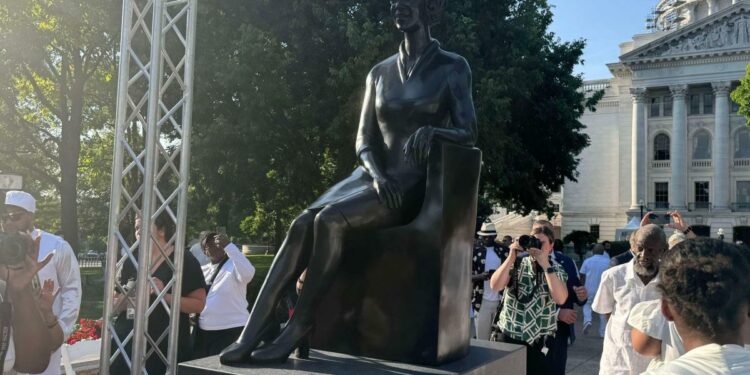The new statue of Vel Phillips was unveiled Saturday at the Wisconsin State Capitol.
First Black restaurant owner in Vermont gets a statue
In Madison, Wisconsin, officials unveiled the statue of Velvalea “Vel” Phillips, created by Radcliffe Bailey, in July on capitol grounds. Phillips achieved many firsts as a Black woman in the state. She died in 2018 at 95. Michael Johnson, president and CEO of the Boys and Girls Clubs of Dane County, said the statue came out of a conversation with activists requesting he use his influence to build representation at the state capitol.
He visited the office of Gov. Tony Evers, a Democrat, and saw a photo of Phillips in the room. Evers had hung it up himself. It inspired Johnson to get her memorialized and he raised nearly $350,000 to get a statue built. A board associated with the state capitol grounds allowed an exception for the Phillips statue to sit near the capitol.
“I’m proud of the hundreds of people who contributed towards this statue and the young activists who challenged me, as one of many leaders, to make sure that there was representation in our state capitol,” Johnson said.
In Rutland, Vermont, a stone statue sits in the city’s downtown area of Erine and Willa Royal. Ernie is credited for being the state’s first Black restaurant owner and the first Black board member of the National Restaurant Association. The statue has stood there since May. The interactive life-sized sculpture features Willa arranging flowers at a table and Ernie working with younger staffers in the restaurant.
Ernie, who died in 1994 at 76, left his estate to support a scholarship for Black students at the Culinary Institute of America. His restaurant, Royal’s Hearthside, operated from 1963 to his death.
Steve Costello, who helped fund the sculpture with his wife Jane and other locals, said the idea began as a way to build a trail with sculptures, but not “the typical sculptures the U.S. has produced of a bunch of old white guys like me,” he said. The group researched and learned about Ernie and his restaurant.
“The sculpture really, for me, captures exactly who they were and what they were in the community,” Costello said. “They were people who drew the community together for big events, for important dinners, for important meals, for the times that you want to remember.”
The ‘whitewashing’ of American history
In Buffalo, the African American Veterans Monument, honoring Black servicemembers, sits at the Buffalo and Erie County Naval and Military Park. In the monument are 12 cylindrical pillars that illuminate at night and represent the 12 wars and peacetime between them. Robin Hodge, chief of operations at AAVM, said the monument started in 2012 with a group of about five Black residents who wanted to honor those servicemembers.

Al Wakefield, left, and Gerry Fernandez, right, pose at the Ernie and Willa Royal statue in Rutland, Vermont. The stone statue is an interactive piece in the town’s downtown area honoring Ernie, the state’s first Black restaurant owner.
Ronal Basshman, a board member of the monument, said it is needed because the country’s history has been “whitewashed over for 300 years.” All of the servicemembers in the monument, Hodge said, served during times of war and peace. The memorial opened in 2022 after New York State Majority Leader Crystal Peoples-Stokes, D-Buffalo, helped secure land for the structure.
In San Francisco, poet Maya Angelou will be immortalized at the city’s main library by artist Lava Thomas. Angelou was known for her autobiography “I Know Why the Caged Bird Sings” and the anthology “And Still I Rise.” Thomas said that creating Angelou’s sculpture is powerful to her as a Black woman; Angelou has been a “shero” to her since Angelou’s autobiography.
Some states pass laws to block removal of monuments
There’s still resistance. Opponents say that removing Confederate monuments is tantamount to erasing history, with some Southern states passing laws to stop their removal.
One example is in Fort Smith, Arkansas, where for over a century, a life-size statue of a Confederate soldier has stood atop a towering monument.
The city administrator had considered removing the monument for years. Then the murder of George Floyd ignited a national conversation about Confederate monuments and sparked new calls to take it down. A local construction company even offered to help.
“This statue is a clear and present ode to the values of the Confederacy that we do not share,” residents wrote in a petition to the city.
But before local leaders could decide its fate, the Arkansas Legislature revoked their power.
Citing the “vandalism” of monuments, Republican state lawmakers passed a law in 2021 that prevents Fort Smith from removing its monument and supplants local control over dozens of other statues across the state.
Arkansas is one of many Southern states that have passed historic preservation laws to strip local leaders of the power to take down Confederate monuments in their communities. Bills in former Confederate states such as Texas and Florida were introduced in Republican-controlled legislatures in 2023. Similar bills are appearing in states that were not part of the Confederacy, including New York and Pennsylvania.

Artist Lava Thomas provided the digital rendering of Maya Angelou that’s expected to be unveiled in San Francisco in 2024 outside of the city’s public library. Angelou died in 2014 and was known for her poems, most notably her autobiography ‘I Know Why the Caged Bird Sings.’
Monuments reflect ‘complicated, better informed’ history
Future monuments are going to be more involved and likely created with intentions to be moved elsewhere, Salamishah and Scheherazade Tillet said. They see the current rising number of Black monuments trickling down to other racial and ethnic groups to better represent not only the country in general, but also the atrocities and achievements of the past. And then, there are memorials to just regular people.
“The people who are being presented are just reflective of America as it’s always been,” Salamishah Tillet said.
The changes will soon affect how people view history, von Daacke said, and reshape the public memory of the country’s or a place’s past.
“We’re at a moment where people, in making these choices, are demonstrating that their interest in history is maybe better informed than it used to be, and certainly much broader and more complicated,” von Daacke said. “The monuments, which are responding to these very particular events over the past couple decades and speaking to a moment, are at least couched in at this moment, a more honest and complete history than we would have had 20 years ago, 100 years ago.”
Contributing: Abhinav S. Krishnan, USA TODAY
Contact reporter Krystal Nurse at [email protected]. Follow her on X, formerly Twitter,@KrystalRNurse.
This article originally appeared on USA TODAY: Confederate statues come down as Black history rises across the U.S.
Source link : http://www.bing.com/news/apiclick.aspx?ref=FexRss&aid=&tid=66caf69df7b34adeb1500c5ea8d2612d&url=https%3A%2F%2Fwww.yahoo.com%2Fnews%2Famericas-newest-monuments-unveil-different-090259483.html&c=2100833255448813116&mkt=en-us
Author :
Publish date : 2024-08-24 22:02:00
Copyright for syndicated content belongs to the linked Source.












